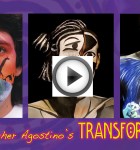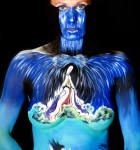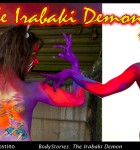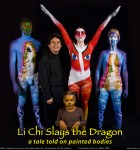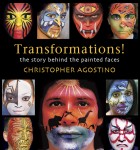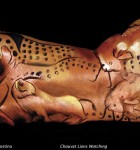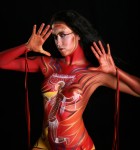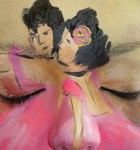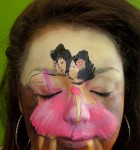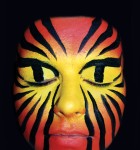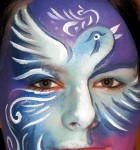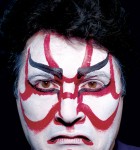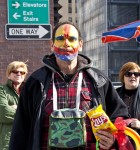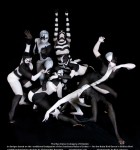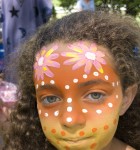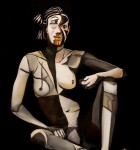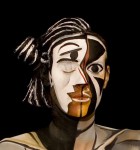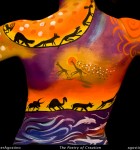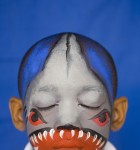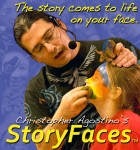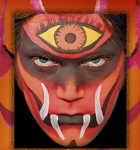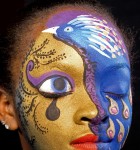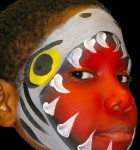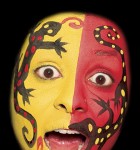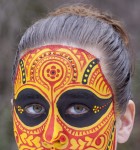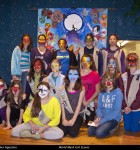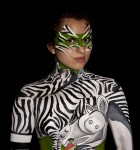I am honored to say I have been nominated for an award by the Society of Unique Artists. I’m one of 5 finalists in the category of Unique Painting, and the winner will be announced at the Unique Art Awards event on September 29 in New York. Upon my nomination I was asked to submit a portfolio for the judges’ consideration, which I am posting here, including this short video artist statement:
Christopher Agostino’s Transformations
I approach the art of transformation as a performance art, whether on stage or at an event.
In 1976 I painted my first face, as a young acting student learning about makeup’s power to transform identity, which led to a lifelong exploration of the cultural traditions of masks and body art. A few hundred thousand faces later, I am the artistic director of the Transformations company, presenting exceptionally creative face and body painting at public events in New York, and I have developed a unique series of stage performances including my signature StoryFaces performances for family audiences, an anthropological program on the cultural significance of these arts called Before Cave Walls…the story on our skin, and Bodies Alive! painted body performances.
You can see the range of what I do in a video encompassing one particular year of my work: 2008 Transformations
 StoryFaces Performances— My primary work is on stage, as a performer, bringing stories to life on the faces of the audience through a unique fusion of spoken word and painted faces. This is a performance style I developed organically over many years as a natural combination of my work as a visual artist, my explorations of the traditional functions of mask art and my experience in the theatre. “The Peacock and the Sun Goddess” is an example of a StoryFace design. See the StoryFaces video and see a full story, “Li Chi Slays the Dragon“, performed at the Philadelphia International Festival of the Arts in 2011.
StoryFaces Performances— My primary work is on stage, as a performer, bringing stories to life on the faces of the audience through a unique fusion of spoken word and painted faces. This is a performance style I developed organically over many years as a natural combination of my work as a visual artist, my explorations of the traditional functions of mask art and my experience in the theatre. “The Peacock and the Sun Goddess” is an example of a StoryFace design. See the StoryFaces video and see a full story, “Li Chi Slays the Dragon“, performed at the Philadelphia International Festival of the Arts in 2011.
BodyStories is an experimental concept in which I am creating a sequential story on the body of a performer to be “told” through storytelling and choreographed movements. An early example is the Irabaki Demon story, painted live at the IMATS Makeup Show in New York 2012.

 Cultural sources: Soon after I began painting faces, an article on Chinese Opera masks led me into researching the cultural sources of masks and body art. This research informs my work today, both in an understanding of all that is possible in face and mask art and in a recognition of my place as a modern artist within the profound and ancient tradition of the mask-maker. In my stage presentations and face painting at events I include faces from world cultures to help elevate the public perception of face painting and redefine it as the modern expression of a traditional art, such as “Theyyam Christine” and the “Kabuki Christopher” face I painted on myself.
Cultural sources: Soon after I began painting faces, an article on Chinese Opera masks led me into researching the cultural sources of masks and body art. This research informs my work today, both in an understanding of all that is possible in face and mask art and in a recognition of my place as a modern artist within the profound and ancient tradition of the mask-maker. In my stage presentations and face painting at events I include faces from world cultures to help elevate the public perception of face painting and redefine it as the modern expression of a traditional art, such as “Theyyam Christine” and the “Kabuki Christopher” face I painted on myself.
Before Cave Walls…the story on our skin: the culmination of my study of cultural origins for my art is this stage presentation for adults and educational settings. See the Before Cave Walls…video Before we ever painted a cave wall, we painted ourselves. We were our own first works of art, and this link to the origins of our humanity remains a fundamentally underpinning of my work. ( see my article on the discovery of a 100,000 year old body painting kit )
The Transformations Face Painting company: As I began to paint faces at events I gathered a dedicated group of New York artists to work with and developed a mask-like face painting style with bold designs that can be quickly painted to maximize the number of faces we can paint and our impact on an event. Transformations is a New York public art form. We paint tens of thousands of people annually at events for the Bronx Zoo, Parks Department and Housing Authority and have set a standard in New York for what a painted face can be. Learn about our face painting At The Zoo.
 Transformations events: At events, our goal is to paint faces so exciting that we draw a crowd of onlookers, surprising each person we paint with a new design, making the people we paint feel like performers as they leave us and move through the crowd. Transformations is a kinetic art form. It is a cumulative art form. My art is not the design I paint on an individual’s face, it is the full group of faces I paint at an event and the response of the people that see them — more important than what I paint on someone is how they feel when they see themselves in the mirror and in the eyes of the people that watch them as they wear this new, fantastic mask identity — more exciting for me than a photograph of a face I paint is seeing that face amongst the crowd, without any context, like a surprising piece of magic breaking into our too real world (my favorite event photo is: Manhattan Papua New Guinea).
Transformations events: At events, our goal is to paint faces so exciting that we draw a crowd of onlookers, surprising each person we paint with a new design, making the people we paint feel like performers as they leave us and move through the crowd. Transformations is a kinetic art form. It is a cumulative art form. My art is not the design I paint on an individual’s face, it is the full group of faces I paint at an event and the response of the people that see them — more important than what I paint on someone is how they feel when they see themselves in the mirror and in the eyes of the people that watch them as they wear this new, fantastic mask identity — more exciting for me than a photograph of a face I paint is seeing that face amongst the crowd, without any context, like a surprising piece of magic breaking into our too real world (my favorite event photo is: Manhattan Papua New Guinea).

 Documenting the ephemeral: My art washes off, so I was very happy for the opportunity to publish a book on my art: Transformations! The Story Behind the Painted Faces, published in 2006 by Kryolan Professional Makeup, with almost 600 photographs. I also attempt to document the cumulative, kinetic aspect of my art with slideshow videos of every face I paint at particular events. Here’s a recent one EveryFace at Materials for the Arts, NYC. And we have a company tradition of producing collectible postcards, an example is included from the current series “Doesn’t Your Face Deserve to be Art?” with a Degas design painted at an event at the Hudson River Museum last year.
Documenting the ephemeral: My art washes off, so I was very happy for the opportunity to publish a book on my art: Transformations! The Story Behind the Painted Faces, published in 2006 by Kryolan Professional Makeup, with almost 600 photographs. I also attempt to document the cumulative, kinetic aspect of my art with slideshow videos of every face I paint at particular events. Here’s a recent one EveryFace at Materials for the Arts, NYC. And we have a company tradition of producing collectible postcards, an example is included from the current series “Doesn’t Your Face Deserve to be Art?” with a Degas design painted at an event at the Hudson River Museum last year.
 Painted Bodies. Living Art. — fine art body painting. The body painting I do is also informed by my understanding of the traditional origins of this art and my desire to create art that surprises and inspires through the act of transformation. My portfolio includes fine art body paintings done in studio to be exhibited as photographs and bodies painted in public as performance art. Angry Ocean/Waterfall Tears was created as a response to the Tsunami in Japan, through the lens of images from an exhibit at the Japan Society of works by the master printmaker Kuniyoshi — and I view this photograph of the body painting as a prime example of why I paint bodies rather than canvas, as the image gains so much from the beautiful eyes of the model.
Painted Bodies. Living Art. — fine art body painting. The body painting I do is also informed by my understanding of the traditional origins of this art and my desire to create art that surprises and inspires through the act of transformation. My portfolio includes fine art body paintings done in studio to be exhibited as photographs and bodies painted in public as performance art. Angry Ocean/Waterfall Tears was created as a response to the Tsunami in Japan, through the lens of images from an exhibit at the Japan Society of works by the master printmaker Kuniyoshi — and I view this photograph of the body painting as a prime example of why I paint bodies rather than canvas, as the image gains so much from the beautiful eyes of the model.  Picasso Nuba is part of an ongoing series of body paintings exploring the connection between the revolutionary modern art of Picasso, Matisse and the like and the inspiration they took from African masks and other tribal arts, and designed to blur the line between canvas painting and body painting: learn about this Modern Primitive Art series.
Picasso Nuba is part of an ongoing series of body paintings exploring the connection between the revolutionary modern art of Picasso, Matisse and the like and the inspiration they took from African masks and other tribal arts, and designed to blur the line between canvas painting and body painting: learn about this Modern Primitive Art series.
Bodies Alive! — painted bodies in performance. Why do I paint on people? Because they bring my art to life. And the best at this are dancers and performers. Coming into this field as an actor I have always seen face and body painting in connection to the theatre, and bring my work on to a stage whenever possible. Bodies Alive! is our company’s collective term for performance art body painting, including both live painting at galleries and events, full scale stage productions including collaborations with dance companies (see the Nuba Bird Dance ) and other artists (see UV Action Painting with Carolyn Roper and Emma Cammack), and painted body fashion shows (see The Odd Ball video )
I, or my work, have appeared on the NBC Today Show, the CBS Early Show, the cover of Abercrombie & Fitch Quarterly (photographed by Bruce Weber), numerous Face and Body Art International Conventions, the World Bodypainting Festival, the National Storytelling Network Conference, the World Science Festival, and for who knows how many people for schools, libraries, theaters, festivals, events and family audiences. Best guess: I’ve painted close to 300,000 people since 1976.
————————————-
Vision for the Future:
Like most artists, I feel compelled to do what I do and, also like most artists, I am never satisfied. I continue to learn, to push myself and to expand both my understanding of my art and its presentation to the public. In recent years I’ve been using additional media to document and extend my art, such as the EveryFaces videos mentioned above and the new foray into creating stories on painted bodies (BodyStories) which I think is an ideal concept for video art, so I am looking for collaborators. As the director of a company of artists I also have an obligation to keep moving forward as a painter, to keep the bar moving higher for all of us.
Painting my first faces at Adventureland Amusement Park in the late 1970s I was unknowingly at a leading edge of the growing popularity of face and body art of all sorts. There are now face and body painting conventions and competitions world-wide that attract thousands of spectators, and, in my company alone, we paint about 15,000 faces at the Bronx Zoo annually. With public interest in face and body art growing, I am continuing to collect information and write articles, examining the current trend in the context of its cultural origins (see my article about Mike Tyson’s Tattoo), aiming towards a book that will be along the lines of The Painted Body by Michel Thévoz (1984), but from a practicing artist’s perspective rather than an anthropologist’s.
I am also writing down the stories I have been performing for all these years to be illustrated by painted faces for a book of StoryFaces.
Face painting is fun. But right from the start, 30 years ago, I knew that if all I was doing was painting the same pop designs over and over again it would get old quick, and so I am very grateful that coming to practise face painting within the cultural concept of a mask art has made this an ongoing adventure for me, to keep me researching into the origins of this art and continuing to create new design concepts and performance aspects.
Performing is even more fun, and it is the most fun when you are there in front of an audience working right at the edge of your ability, trying something you have never done before. As I recently heard Yo Yo Ma say: “We want to do two things. We want to do something very well, but we also want to take a certain amount of risk, to go to the edge where you see a better view.” That is my Vision for the Future, to keep searching for that edge.
————————————————
“I believe that more important than the design you get painted with is the experience of being painted, the experience of seeing a new identity when you look in the mirror, and how that identity is perceived when others look at you. A facepainter, by changing how the world perceives the person they have painted, alters that person’s perception of the world and of themselves.”

